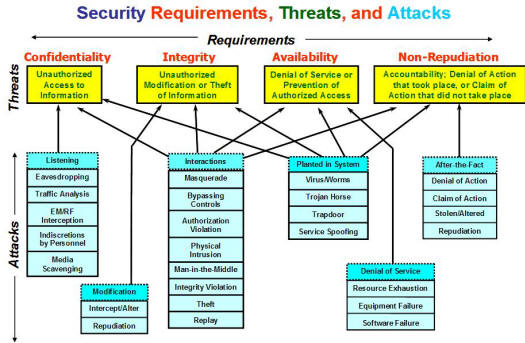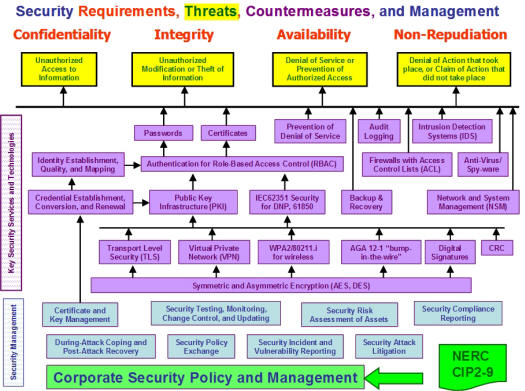Security for Power System Operations
-
NIST Cyber Security Working Group (CSWG):
Support for Smart Grid Cyber
Security Working Group (CSWG) in the development of the
NISTIR 7628, covering cyber security strategy, high
level security requirements, security architecture and
diagrams, privacy, logical interface categories, and other
security issues.
-
Distribution System Security Guidelines for EPRI:
to identify the security
requirements, and to describe the different security
technologies and procedures that utilities could utilize for
meeting those requirements, based on NIST/EPRI FERC4+2
diagrams, the NIST CSWG efforts, and the NIST Catalog of
Control System Security.
-
AMI
and HAN Cyber Security Requirements for EPRI:
to develop the security
requirements and methodology for utilities to utilize for
developing implementation-specific security requirements,
based on NIST/EPRI FERC4+2 diagrams, the NIST CSWG efforts,
and the NIST Catalog of Control System Security.
-
As
Convenor of IEC TC57 WG15 on Security
for Power System Operations,
have led the development of
security standards for utility operations protocols,
including ICCP, IEC 61850, and DNP. In addition, the
development of Network and System Management data objects
for power system operations, to help ensure security and
reliability of end-to-end systems. These security standards,
most of which have just been approved by the international
committees, consist of IEC 62351: Data and Communication
Security – Part 1: Introduction, Part 2: Glossary, Part 3:
Profiles Including TCP/IP, Part 4: Profiles Including MMS,
Part 5: Security for IEC 60870-5 and Derivatives (i.e.
DNP3), Part 6: Security for IEC 61850 Profiles, and Part 7:
Security Through Network and System Management. New security
efforts will include security requirements for wireless
communications as well as additional profiles of protocols
used in the power system industry.
-
As
Chair of
IEEE PES PSCC Security WG,
am heading the development
for the IEEE of Recommended Practices, educational material,
and other information related to the assessment of
information security risks in power system operations.
-
Assessment of Substation Physical Security Measures within
Substations, EPRI 1011752,
March 2006. The need for physical security of substations is
becoming more urgent as power systems are operated closer to
their limits, as information systems become increasingly
important to power system operations, and as sophisticated
substation equipment becomes more vulnerable to physical
threats due not only to deliberate attacks but also to
inadvertent mistakes, failures, and natural catastrophes.
This requirement for physical security affects all
substation assets to one degree or another. The key is the
tradeoff between the costs (monetary and some reduced
efficiency) of implementing security measures and the
probabilistic benefits associated with avoided costs
(monetary, social, political, and legal).
-
Security Risk Assessment and Mitigation Procedure for TVA
Operational Information Assets, March 2005.
Cyber security has
undoubtedly become a major issue for almost all electric
utilities. This is partly due to the competitive
environment, where crucial information (gathered legally or
illegally) can translate into millions of dollars, but
mainly due to the increased vulnerability brought about by
the integration of networking technologies within the
systems and equipment used on the power system. It is
particularly true for the United States that a loss of
electrical power for any extended time and over a large area
can have serious consequences for the economy, for the
safety of people, and for the legal and financial status of
the utilities affected. PowerWAN will be a vital part of
TVA’s future. Physical infrastructure alone is not enough to
meet the challenge. To be successful, sound security policy,
risk assessment practices, and mitigation procedures must be
developed. These requirements were analyzed and discussed in
the report.
-
Scoping Study on Security Processes and Impacts, July 2003,
EPRI 057144. The primary
objective of this Scoping Study was the assessment of the
financial and societal costs of implementing security
measures. Financial costs include the costs for developing
security policies and implementing security countermeasure
technologies. Societal costs include the impact of security
policies and technologies on the efficiency of personnel and
systems.
-
Security Enhancements for Utility Information Architectures,
August, 2002, EPRI EP-P10074.
Cyber security has become a major issue in utilities due
partly to the increased vulnerability of utilities as they
network their computer systems and power system equipment;
and partly due to the competitive environment where crucial
information (gathered legally or illegally) can translate
into millions of dollars. A number of technology solutions
have been proposed for improving the security of the
communications protocols used in power system operations,
mostly based on encryption which does have an impact on
performance. These solutions go a long way to increasing the
information security. However, they are not the complete
story – for end-to-end security beyond the protocols,
additional types of security are needed. The objectives of
this project was to assess the impact on performance of the
security measures being proposed for the common protocols
used for digital control of power system equipment, and to
determine what additional security measures outside the
domain of protocols may be needed for complete end-to-end
security.
-
Security Primer on communication network security
requirements for utility T&D operations.
The primary focus of this
work was to describe the potential areas of vulnerability of
utility SCADA systems, substation automation, and other
power system operational automation.


|